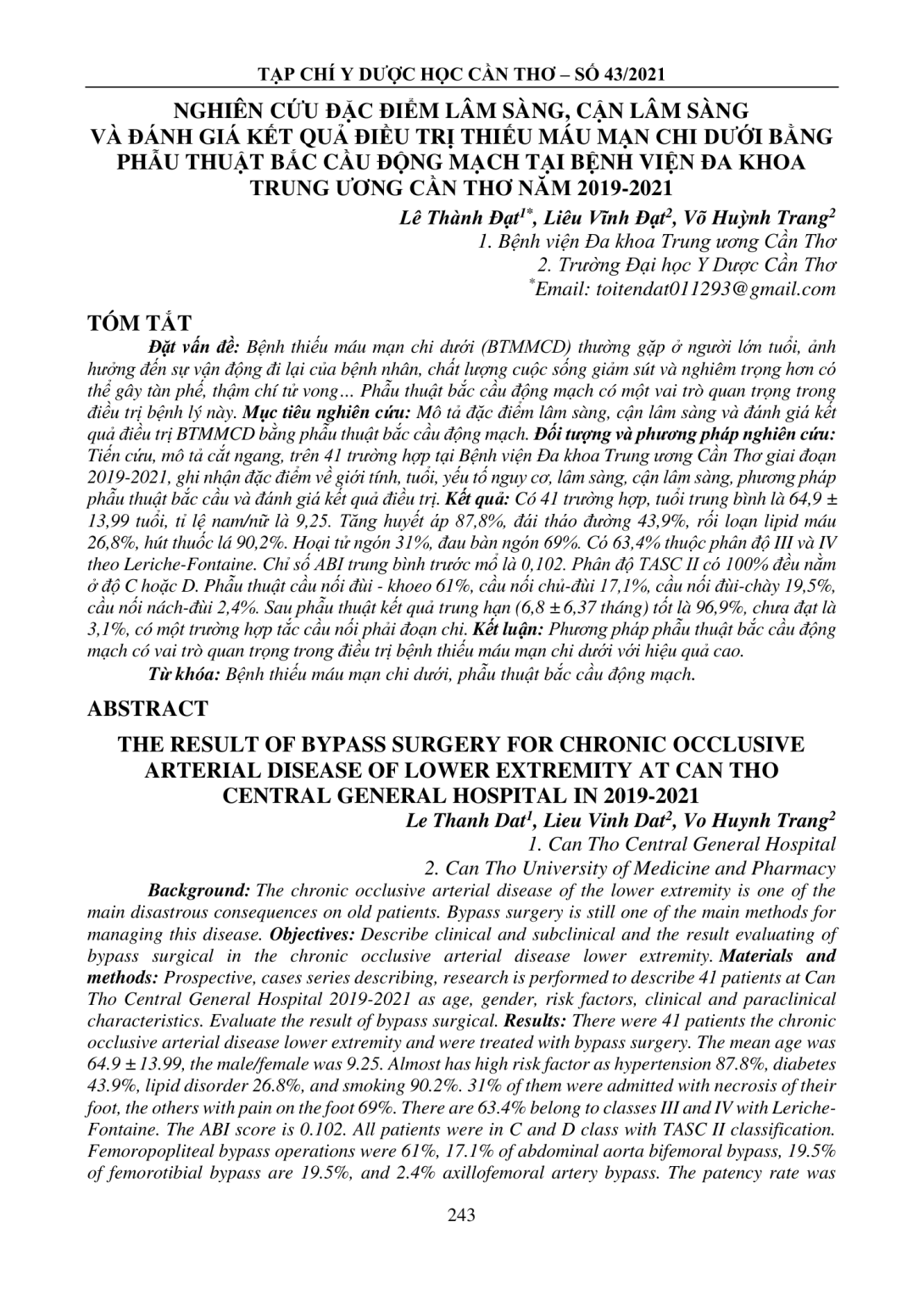
Bệnh thiếu máu mạn chi dưới (BTMMCD) thường gặp ở người lớn tuổi, ảnh hưởng đến sự vận động đi lại của bệnh nhân, chất lượng cuộc sống giảm sút và nghiêm trọng hơn có thể gây tàn phế, thậm chí tử vong… Phẫu thuật bắc cầu động mạch có một vai trò quan trọng trong điều trị bệnh lý này. Mục tiêu nghiên cứu: Mô tả đặc điểm lâm sàng, cận lâm sàng và đánh giá kết quả điều trị BTMMCD bằng phẫu thuật bắc cầu động mạch. Đối tượng và phương pháp nghiên cứu: Tiến cứu, mô tả cắt ngang, trên 41 trường hợp tại Bệnh viện Đa khoa Trung ương Cần Thơ giai đoạn 2019-2021, ghi nhận đặc điểm về giới tính, tuổi, yếu tố nguy cơ, lâm sàng, cận lâm sàng, phương pháp phẫu thuật bắc cầu và đánh giá kết quả điều trị. Kết quả: Có 41 trường hợp, tuổi trung bình là 64,9 ± 13,99 tuổi, tỉ lệ nam/nữ là 9,25. Tăng huyết áp 87,8%, đái tháo đường 43,9%, rối loạn lipid máu 26,8%, hút thuốc lá 90,2%. Hoại tử ngón 31%, đau bàn ngón 69%. Có 63,4% thuộc phân độ III và IV theo Leriche-Fontaine. Chỉ số ABI trung bình trước mổ là 0,102. Phân độ TASC II có 100% đều nằm ở độ C hoặc D. Phẫu thuật cầu nối đùi - khoeo 61%, cầu nối chủ-đùi 17,1%, cầu nối đùi-chày 19,5%, cầu nối nách-đùi 2,4%. Sau phẫu thuật kết quả trung hạn (6,8 ± 6,37 tháng) tốt là 96,9%, chưa đạt là 3,1%, có một trường hợp tắc cầu nối phải đoạn chi. Kết luận: Phương pháp phẫu thuật bắc cầu động mạch có vai trò quan trọng trong điều trị bệnh thiếu máu mạn chi dưới với hiệu quả cao.
The chronic occlusive arterial disease of the lower extremity is one of the main disastrous consequences on old patients. Bypass surgery is still one of the main methods for managing this disease. Objectives: Describe clinical and subclinical and the result evaluating of bypass surgical in the chronic occlusive arterial disease lower extremity. Materials and methods: Prospective, cases series describing, research is performed to describe 41 patients at Can Tho Central General Hospital 2019-2021 as age, gender, risk factors, clinical and paraclinical characteristics. Evaluate the result of bypass surgical. Results: There were 41 patients the chronic occlusive arterial disease lower extremity and were treated with bypass surgery. The mean age was 64.9 ± 13.99, the male/female was 9.25. Almost has high risk factor as hypertension 87.8%, diabetes 43.9%, lipid disorder 26.8%, and smoking 90.2%. 31% of them were admitted with necrosis of their foot, the others with pain on the foot 69%. There are 63.4% belong to classes III and IV with LericheFontaine. The ABI score is 0.102. All patients were in C and D class with TASC II classification. Femoropopliteal bypass operations were 61%, 17.1% of abdominal aorta bifemoral bypass, 19.5% of femorotibial bypass are 19.5%, and 2.4% axillofemoral artery bypass. The patency rate was 96,9%, and amputation was 3.1% (6.8 ± 6.37 month). Conclusion: Bypass surgery is the main method with good results in the chronic occlusive arterial disease lower extremity
- Đăng nhập để gửi ý kiến
